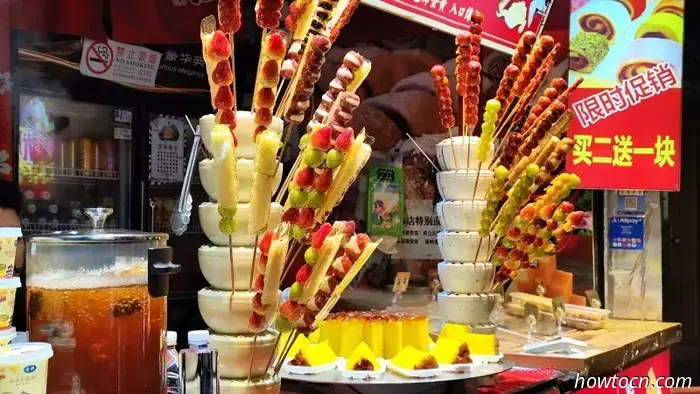
If you've recently been exploring any of Beijing's tourist hotspots or malls, or have scrolled through Chinese social media, you may have noticed that tanghulu has a fresh look! The latest food trend in China, milk skin tanghulu 奶皮子糖葫芦 nǎi pízi tánghúlu, offers a new twist on the classic street snack; what began as a regional novelty has rapidly gained popularity in the mainstream. But what exactly is milk skin tanghulu, and why has it captured so much attention?
What Is It?
Milk skin, or 奶皮子 nǎi pízi, is a dairy specialty from Inner Mongolia, where simmered milk is allowed to cool, forming a crisp, honeycomb-like layer on top. This trendy snack merges milk skin with traditional tanghulu, or candied hawthorns, resulting in a treat that is both sweet and creamy, featuring the crunchy texture of tanghulu and the chewy consistency of milk skin.
There are several variations of milk skin tanghulu. The most popular version simply adds a thin layer of milk skin to a classic tanghulu. Other kinds may involve slicing hawthorns or other fruits like strawberries or grapes in half, then sandwiching cubes of thick, yogurt-like milk skin in between before coating the entire thing in sugar. There is also an “all-in-one” version, where the fruit is halved, filled with milk skin, and coated in sugar, followed by an additional layer of milk skin.
Why Has It Become Popular?
A significant factor behind this trend is the blend of tradition and innovation. The combination of two classic foods provides a fresh and exciting snack while retaining authentic flavors. For many, milk skin tanghulu symbolizes the reinvention and rebranding of Beijing's traditional street snacks for a generation that seeks something both classic and stylish.
However, like any food trend, there are additional reasons for its appeal. Retailers have strategically limited purchases to two sticks of milk skin tanghulu per customer to create a sense of scarcity. Concurrently, numerous influencers and food enthusiasts have shared images and videos of long lines on social media, along with “check-in guides” offering information on popular brand locations, operating hours, and optimal times to avoid long waits.
Not everyone is on board with this trend, however. Some trendy shops are charging up to RMB 98 for sticks of milk skin tanghulu, compared to a traditional stick that costs around RMB 5-15, leading to substantial criticism of the inflated prices. The lengthy wait times have also prompted some netizens to question why anyone would stand in line for something that is, in essence, just a tanghulu.
While this fashionable new snack may seem like a seasonal novelty, the success of milk skin tanghulu hints that other traditional snacks and lesser-known heritage foods could also become viral trends in the future. All it takes is the right mix of regional uniqueness, visual appeal, and social media excitement, so stay alert for the next big craze!
Milk Skin Tanghulu in Beijing
You can find numerous places in Beijing to sample this viral snack, notably in popular tourist spots like Houhai and Nanluoguxiang, as well as in various malls, where several trendy brands have emerged. Some of the most recognized include NIBU Yogurt, Friendly Crush, Gelegle, CozyCow, and MOO Yogurt. More traditional brands like Lao Beijing Tanghulu and Jingxi Tanghulu have also embraced the trend. For additional recommendations, you can check out a post from our sister account, the Beijinger Chinese.





Snack Attack: Understanding the Milk Skin Tanghulu Trend